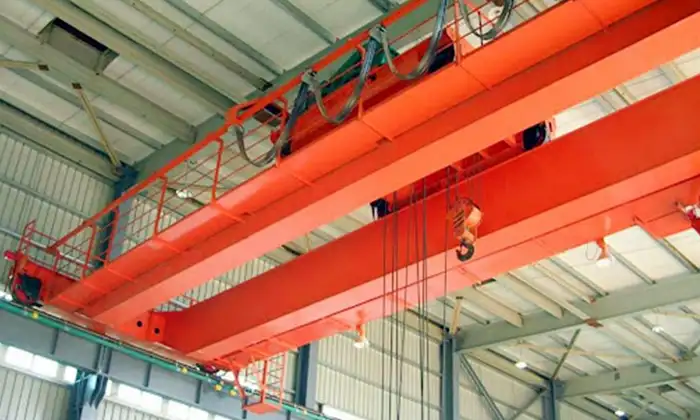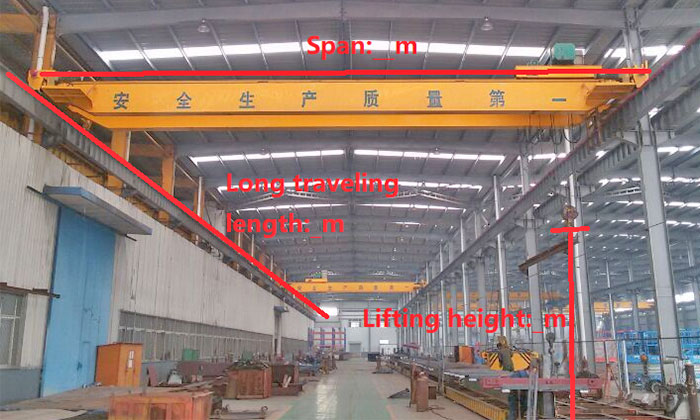Handling Heavy Loads with 20Ton Bridge Cranes in Shaft Stations
Efficient Vertical Transport: Managing Heavy Loads with 20 ton Bridge Cranes in Shaft Stations
Shaft stations, positioned at key points along vertical shafts, act as vital centers for miners, equipment, and important materials. They link the surface with the underground operations, making them essential components of mining activities.
Efficient vertical transport within these stations is crucial for successful mining operations. The ability to load and unload materials onto cages or skips moving through the shafts is essential for maintaining a steady flow of resources underground.
Bridge cranes, specifically designed for heavy load handling, are customized to tackle the challenges encountered in shaft stations. Their role in loading and unloading materials onto the cages or skips for vertical transportation is fundamental to the seamless operation of mining activities.
With a deep understanding of the importance of efficient vertical transport in shaft stations and the pivotal role of 20 ton bridge cranes, let's explore further the intricate workings and key aspects of these robust machines.
Overview of Shaft Stations
In the intricate web of underground mining, shaft stations serve as critical nodes, facilitating the movement of essential materials, machinery, and personnel between the surface and the subterranean mining sites. These stations stand as vital connections bridging the gap between the depths of the mine and the surface operations.
Shaft stations are essentially like bustling terminals along the vertical shafts, strategically positioned to manage the inbound and outbound flow of resources. Their functionality extends beyond mere transport hubs; they act as operational nuclei where materials are loaded onto and offloaded from conveyances like cages or skips for their journey up and down the mine's vertical shafts.
Their significance lies not only in the movement but also in the coordination and orchestration of resources within the underground mine. They are the heart of efficient resource management, ensuring the timely transport of ores, supplies, and equipment to their requisite destinations.
Vertical Transport Challenges in Shaft Stations
Within the confined and often challenging spaces of shaft stations, vertical transport encounters various hurdles. Limited space and the need for precision in maneuvering heavy loads pose significant challenges. Moving materials seamlessly between different levels of the mine demands specialized equipment capable of withstanding the demands of the environment while ensuring safety and efficiency.
Moreover, the operation of shaft stations demands consistent and reliable vertical transport to sustain mining operations. Any disruption or inefficiency in this vertical movement can impede the entire mining process, leading to delays and decreased productivity.
Need for Heavy Load Handling Capabilities
Handling heavy loads is a central necessity within shaft stations. Materials, machinery components, and ores transported through the vertical shafts often weigh several tons. Consequently, the equipment used must possess robust load-handling capabilities to manage these hefty loads efficiently and safely.
The need for heavy load handling capabilities in these stations is not merely a convenience but an operational imperative. It's about ensuring that the crucial resources and materials necessary for the continuity of mining operations are moved swiftly and securely between the surface and the underground depths.
Double girder bridge crane with explosion proof design for sale
Role of 20 ton Bridge Cranes in Shaft Stations
The 20 ton bridge crane's design encompasses key features tailored for heavy load handling. Equipped with robust hoists, durable trolleys, and precisely engineered bridge girders, these cranes demonstrate exceptional lifting capacity coupled with precision maneuverability. Their reliability and stability make them indispensable assets in the operational infrastructure of shaft stations.
The utilization of 20 ton bridge cranes in shaft stations offers a myriad of advantages. Their ability to handle substantial loads with precision ensures the seamless loading and unloading of materials onto conveyances, ensuring a steady and uninterrupted flow of resources. These cranes operate with remarkable efficiency, contributing significantly to the overall productivity of mining operations.
Their adaptability to varying load sizes and types is a substantial advantage. From heavy machinery components to bulk materials, the versatility of these cranes allows for the safe and efficient handling of diverse loads encountered within the shaft stations. Additionally, their reliability minimizes downtime and operational disruptions, enhancing the overall efficiency of the mining process.
Engineered with meticulous attention to detail, 20 ton bridge cranes incorporate specific design elements essential for handling heavy loads within the confines of shaft stations. Their sturdy construction, coupled with specialized components like reinforced hooks, advanced control systems, and precision lifting mechanisms, ensures the secure and precise movement of hefty materials.
Moreover, these cranes often integrate safety features such as overload protection and emergency braking systems, prioritizing the safety of both personnel and valuable resources. The precision controls and ergonomic designs further contribute to the safe and efficient maneuvering of heavy loads within the confined spaces of shaft stations.
Applications of 20 ton Bridge Cranes
Loading and Unloading Operations in Shaft Stations
One of the primary applications of 20 ton bridge cranes within shaft stations lies in their pivotal role in loading and unloading operations. These cranes serve as stalwart allies in swiftly and securely moving materials onto and off conveyances like cages or skips destined for vertical movement.
The precision and lifting capacity of these cranes play a crucial role in ensuring the efficient loading and unloading of a wide array of materials, ranging from heavy machinery components to raw ores. Their robust design and maneuverability enable operators to handle these tasks with exceptional accuracy and safety, optimizing the resource flow within the shaft station.
Transporting Materials onto Cages or Skips for Vertical Movement
At the heart of the vertical transport process in shaft stations lies the intricate task of safely loading materials onto cages or skips for their journey up and down the mine shafts. Here, the 20 ton bridge crane takes center stage, lifting and positioning materials onto these conveyances with precision.
The crane's ability to handle substantial loads ensures the efficient transfer of materials onto the conveyances, setting the stage for their vertical movement within the mine. This critical step in the process demands reliability and accuracy, making the 20 ton bridge crane an indispensable asset in facilitating the smooth and safe vertical transport of resources.
Handling Heavy Equipment and Machinery
Beyond materials, the applications of 20 ton bridge cranes extend to the handling of heavy equipment and machinery within shaft stations. These cranes are equipped to maneuver and position hefty machinery components and equipment parts, contributing significantly to maintenance and repair activities.
Their robust load-handling capabilities and precision controls enable the safe and efficient handling of heavy machinery components, ensuring their timely movement for maintenance, repair, or installation tasks. The ability to handle diverse loads, including bulky machinery, showcases the versatility and adaptability of these cranes within the confined spaces of shaft stations.
Safety Measures and Operational Considerations
Importance of Safety Protocols in Vertical Transport
In the realm of vertical transport within shaft stations, safety reigns supreme. The deployment of 20 ton bridge cranes, while instrumental in enhancing efficiency, is also accompanied by stringent safety protocols. The significance of safety measures cannot be overstated in operations involving heavy loads and confined spaces.
Safety protocols encompass meticulous planning, risk assessment, and adherence to established procedures to ensure the safety of personnel, resources, and equipment. Prioritizing safety not only mitigates potential hazards but also ensures the smooth and uninterrupted flow of materials within the shaft station.
Training Requirements for Operators and Maintenance Personnel
The operation and maintenance of 20 ton bridge cranes demand skilled and trained personnel. Operators and maintenance staff undergo comprehensive training programs to understand the intricacies of crane operations, safety procedures, and maintenance requirements.
This training equips them with the expertise needed to maneuver the crane, handle heavy loads with precision, and perform routine maintenance tasks. Proficiently trained personnel play a pivotal role in ensuring the safe and efficient operation of cranes within the confines of shaft stations.
Compliance with Safety Standards and Regulations
Operating within the mining industry mandates strict compliance with safety standards and regulations. These standards, set by regulatory bodies, are designed to uphold the highest safety standards in mining operations, including the utilization of heavy machinery like 20 ton bridge cranes.
Compliance involves regular inspections, adherence to safety guidelines, and maintaining records of maintenance and operational procedures. By adhering to these standards and regulations, mining operations ensure a safe working environment, mitigate risks, and uphold the well-being of personnel and assets.
In the following section, we'll explore real-world case studies and success stories highlighting the implementation of stringent safety measures and operational considerations in the use of 20 ton bridge cranes within shaft stations.
Future Developments and Enhancements
Innovations in Bridge Crane Technology for Shaft Station Applications
The world of crane technology continues to evolve, and innovative advancements are underway to further enhance the capabilities of 20 ton bridge cranes specifically tailored for shaft station applications. Ongoing research and development initiatives aim to introduce cutting-edge features that address the unique challenges faced within these confined spaces.
Innovations such as advanced control systems for increased precision, smart sensors for improved safety measures, and enhanced load monitoring capabilities are being integrated into bridge crane designs. These advancements promise to elevate the efficiency and safety standards of vertical transport within shaft stations.
Potential Upgrades or Modifications to Further Enhance Performance
As mining operations evolve, so do the demands placed on equipment like 20 ton bridge cranes. Potential upgrades or modifications are being explored to augment their performance and adaptability within shaft stations. Upgrades in load-handling capacities, increased automation for more streamlined operations, and ergonomically enhanced designs are under consideration.
Furthermore, modifications aimed at optimizing space utilization and reducing the environmental footprint of crane operations within shaft stations are being studied. These enhancements aim to further improve operational efficiency while adhering to sustainability principles.
Predictions for the Evolution of Vertical Transport in Shaft Stations
Looking ahead, the future of vertical transport within shaft stations holds promising advancements driven by technological innovation. Predictions indicate a trajectory of increased efficiency, reliability, and safety in the utilization of 20 ton bridge cranes.
Anticipated developments foresee even more intelligent and autonomous crane systems, employing predictive maintenance algorithms and real-time data analytics to preemptively address operational issues. Moreover, seamless integration with emerging technologies like AI and IoT is expected to further refine the precision and adaptability of these cranes within shaft stations.
Get your customized overhead crane
Get your customized overhead crne for shaft station
Throughout this exploration, the pivotal role of 20 ton bridge cranes in shaft stations of underground mining has been vividly illustrated. These robust and versatile cranes stand as linchpins in ensuring the efficient movement of heavy loads within the confined spaces of shaft stations. They serve as instrumental tools in facilitating the seamless loading and unloading of materials onto conveyances, ensuring the steady flow of resources critical for mining operations.
The utilization of 20 ton bridge cranes yields a multitude of benefits that significantly enhance the efficiency and productivity of shaft stations. Their robust load-handling capabilities, precision maneuverability, and adaptability to various load types streamline loading operations and minimize downtime. The seamless integration of these cranes translates into improved efficiency gains, reduced operational disruptions, and heightened safety within the shaft stations.
As the mining industry propels toward advancements driven by technological innovations, the future role of 20 ton bridge cranes in vertical transport remains promising. These cranes, evolving with cutting-edge technologies, are poised to play an even more pivotal role. With continuous enhancements and refinements in design, safety measures, and adaptability, they are poised to revolutionize vertical transport within shaft stations further.
The enduring significance of 20 ton bridge cranes in facilitating efficient material handling and their potential to adapt to future industry demands highlight their indispensable role in the ever-evolving landscape of underground mining operations.




